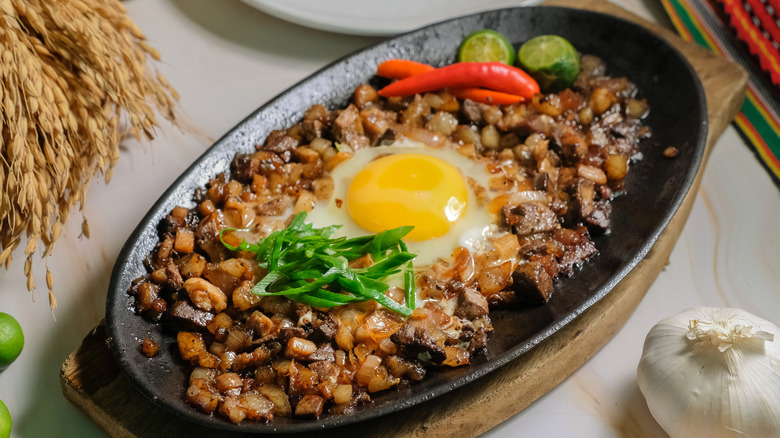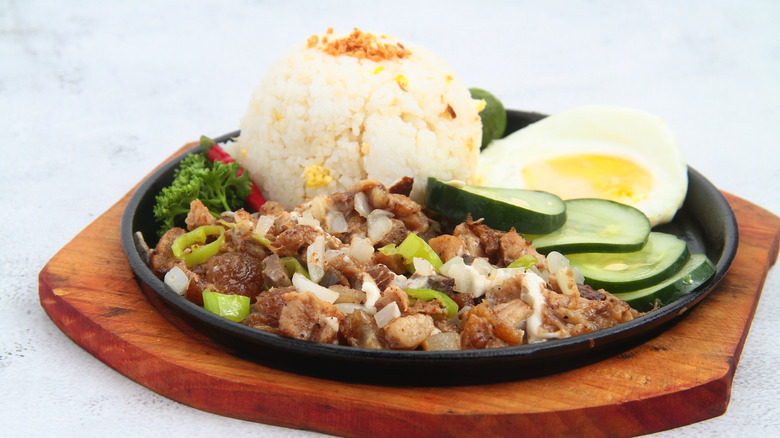Bourdain Called This Food 'The Best Thing You Could Ever Eat With A Cold Beer'
Anthony Bourdain enjoyed the Philippines so much that he featured the country's cuisine at the heart of two of his shows — once in a 2009 episode of "No Reservations" and again in 2016 in the seventh season premiere of "Parts Unknown."
It was no secret that the country loved him back because he did something no Western celebrity chef had done before: he saw Filipino cuisine as they did. As cookbook author and restauranteur Jacqueline Chio-Lauri opined in HuffPost, "He understood what food meant to the people who made and ate it, and he was careful to treat the food ― and, by extension, Filipinos ― with respect."
Even today, Bourdain's words of praise for Filipino food staples are quoted in the country as gospel truth. Of a lechon (Filipino roast pig) he ate there, he said to the chef, "not to kiss your ass, but it is the finest pig I've ever had." Heaping on the praise, he called the milky, shaved ice halo-halo dessert "wondrous" and referred to sisig as "possibly the best thing you could eat with a cold beer," according to Eater.
Sisig wasn't always what it is today
Sisig wasn't always up there on the list of best-known Filipino dishes. Fans are likely to know all about adobo, the flavorful dish made with either chicken or pork and consumed with heaping portions of steaming white rice. They may have heard about the lechon Cebu Bordain ate, where whole roast pigs are covered with spices, put on a giant spit, and roasted over an open fire. Filipino food fans would have known about the country's obsession with crisp spring rolls, also known as lumpia, which can be filled with just about anything from meat and vegetable to banana and brown sugar. And then there's one of the country's most popular appetizers, ranked as a must-try for anyone who has paid a visit to the country: sisig.
According to Pepper, the first mention of sisig dates to 1732 and described the dish as a salad of green papaya or guava, tossed in a dressing made with salt, pepper, garlic, and vinegar. The Spanish (who had earlier colonized the Philipines) had a version of sisig that was a sour concoction meant to quell one's urge to vomit. It was only when American troops arrived in the Philipines at the close of the 19th century that sisig is said to have made the leap from hangover cure to side dish.
Sisig was first made out pig scraps in the 1970s
Modern-day sisig was inspired by the desire to limit food waste generated by U.S. troops who were stationed in the Philippines during the early 20th century. Cooks for the armed forces commissary threw out pig heads until they eventually started selling that part of the pig to beer joints in the area. Bar owners would save the ears and jowls and throw those pieces into the sour salad, which they would serve as a snack.
It was in the 1970s that restaurant owner Aling Lucing Cunanan decided to level up her sisig and reinvented the dish by grilling the chopped ears and cheeks, seasoning them with vinegar and calamansi juice, and adding chopped chicken livers and onions. She then tossed the grilled meat and vegetable medley onto a sizzling hot platter before serving, creating the dish we know and love today.
It might have taken a while, but sisig has finally been getting its due. It was introduced to diners in the U.S. when Filipino restaurants like New York's Maharlika went mainstream. CNN, which produced "Parts Unknown," even included it in a roundup of "Dishes that Define the Philippines," but the endorsement sisig fans across the country keep closest to their hearts is when Bourdain called sisig his "single favorite Filipino street food."


